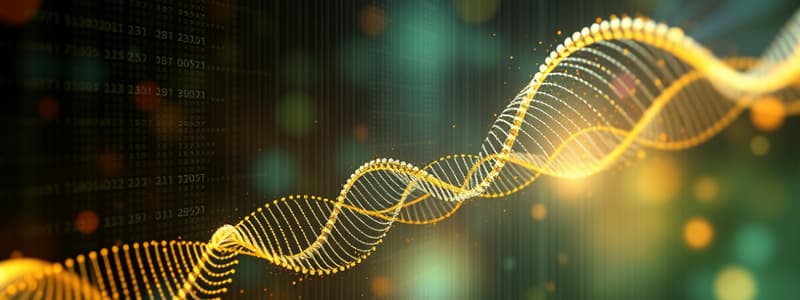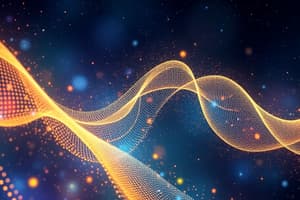Podcast
Questions and Answers
What is the primary purpose of local alignments in bioinformatics?
What is the primary purpose of local alignments in bioinformatics?
Global alignment allows for the identification of shared domains or motifs between proteins.
Global alignment allows for the identification of shared domains or motifs between proteins.
False
What commonly used tool in bioinformatics is based on pairwise alignment?
What commonly used tool in bioinformatics is based on pairwise alignment?
BLAST
A pairwise alignment is a process of lining up two sequences to achieve maximum levels of ______.
A pairwise alignment is a process of lining up two sequences to achieve maximum levels of ______.
Signup and view all the answers
Match the following alignment types with their descriptions:
Match the following alignment types with their descriptions:
Signup and view all the answers
During global alignment, what can be introduced to optimize matching?
During global alignment, what can be introduced to optimize matching?
Signup and view all the answers
Mismatches and indels in aligned sequences indicate random changes.
Mismatches and indels in aligned sequences indicate random changes.
Signup and view all the answers
What process is used to decide if two genes or proteins are structurally or functionally related?
What process is used to decide if two genes or proteins are structurally or functionally related?
Signup and view all the answers
What is the main purpose of sequence alignment in bioinformatics?
What is the main purpose of sequence alignment in bioinformatics?
Signup and view all the answers
A global alignment matches sequences over their entire length.
A global alignment matches sequences over their entire length.
Signup and view all the answers
What are the three main components of alignments?
What are the three main components of alignments?
Signup and view all the answers
In sequence alignment, gaps are caused by _____ or deletion of residues.
In sequence alignment, gaps are caused by _____ or deletion of residues.
Signup and view all the answers
Which type of alignment focuses on a subset of sequences rather than all?
Which type of alignment focuses on a subset of sequences rather than all?
Signup and view all the answers
An ortholog is a gene that has diverged within the same species.
An ortholog is a gene that has diverged within the same species.
Signup and view all the answers
What is the difference between homology, similarity, and identity in sequence alignment?
What is the difference between homology, similarity, and identity in sequence alignment?
Signup and view all the answers
Match the following terms with their correct definitions:
Match the following terms with their correct definitions:
Signup and view all the answers
What does a good alignment in genetics aim to achieve?
What does a good alignment in genetics aim to achieve?
Signup and view all the answers
Identity refers solely to the number of identical amino acids in a sequence.
Identity refers solely to the number of identical amino acids in a sequence.
Signup and view all the answers
What term is used for homologous proteins from different species that have the same function?
What term is used for homologous proteins from different species that have the same function?
Signup and view all the answers
The extent to which nucleotide or protein sequences are related after alignment is known as __________.
The extent to which nucleotide or protein sequences are related after alignment is known as __________.
Signup and view all the answers
Match the following terms with their definitions:
Match the following terms with their definitions:
Signup and view all the answers
In the context of similarity matrices, what do they specify?
In the context of similarity matrices, what do they specify?
Signup and view all the answers
Two sequences can have a similarity of 60% and an identity of 40% and still not show any homology.
Two sequences can have a similarity of 60% and an identity of 40% and still not show any homology.
Signup and view all the answers
Name one critical factor that impacts the quantification of identity in sequences.
Name one critical factor that impacts the quantification of identity in sequences.
Signup and view all the answers
What term is used for homologous proteins that have different functions within the same species?
What term is used for homologous proteins that have different functions within the same species?
Signup and view all the answers
Homology is a measure of similarity between proteins.
Homology is a measure of similarity between proteins.
Signup and view all the answers
What is a collection of three or more protein sequences that are aligned called?
What is a collection of three or more protein sequences that are aligned called?
Signup and view all the answers
Homologs that have arisen by gene duplication within the same species are known as __________.
Homologs that have arisen by gene duplication within the same species are known as __________.
Signup and view all the answers
Which of the following statements is true regarding orthologs?
Which of the following statements is true regarding orthologs?
Signup and view all the answers
Match the following terms with their definitions:
Match the following terms with their definitions:
Signup and view all the answers
Paralogs can have distinct functions even though they are related.
Paralogs can have distinct functions even though they are related.
Signup and view all the answers
Name an example of a protein family where genes can be classified as paralogs.
Name an example of a protein family where genes can be classified as paralogs.
Signup and view all the answers
What is the primary role of retinol-binding protein?
What is the primary role of retinol-binding protein?
Signup and view all the answers
Sequence alignment can help identify conserved regions between organisms.
Sequence alignment can help identify conserved regions between organisms.
Signup and view all the answers
What is the significance of DNA alignments in protein studies?
What is the significance of DNA alignments in protein studies?
Signup and view all the answers
The primary function of alpha-1-microglobulin is to __________.
The primary function of alpha-1-microglobulin is to __________.
Signup and view all the answers
Match the proteins with their primary roles:
Match the proteins with their primary roles:
Signup and view all the answers
Which of the following methods can help in gene finding?
Which of the following methods can help in gene finding?
Signup and view all the answers
Homology and prediction models for proteins can yield different results.
Homology and prediction models for proteins can yield different results.
Signup and view all the answers
What does measuring sequence similarity help to observe?
What does measuring sequence similarity help to observe?
Signup and view all the answers
Study Notes
Learning Outcomes
- Differentiate local and global alignment events.
- Construct pairwise sequence alignments.
- Distinguish between pairwise and multiple sequence alignments.
- Understand the concepts of homology, similarity, and identity.
- Define orthologs and paralogs.
- Evaluate the significance of sequence alignments in bioinformatics.
Sequence Alignment
- Involves comparing DNA or protein sequences to assess similarity/dissimilarity.
- Comparisons based on the order of sequences or sequence patterns.
- Produces an alignment that highlights perfect matches, mismatches, and gaps (insertions/deletions).
Alignment Components
- Perfect Matches: Identical characters between sequences.
- Mismatches: Different characters aligned together.
- Gaps: Represented by a dash, indicating indels in the sequences.
Local Alignments
- Focused on identifying the best matching segments within two sequences.
- Forms the basis for database searching methods like BLAST.
- Useful for identifying protein domains and motifs.
Global Alignment
- Aims for the best match over the entire length of two similar sequences.
- Introduces gaps for better alignment of sequences of equal lengths.
Pairwise Alignment
- Compares two sequences for maximum identity.
- Helps in determining structural or functional relations between genes or proteins.
- Basis for genome analysis and BLAST searching.
Similarity, Identity, and Conservation
- Similarity measures the extent of relatedness among aligned sequences.
- Identity quantifies the number of exact matches at specific positions.
- Conservation indicates changes that maintain physical/chemical properties of amino acids or nucleotides.
Homology
- Refers to evolutionary relationships descending from a common ancestor.
- Orthologs: Homologous proteins with similar function in different species.
- Paralogs: Homologous proteins with different functions arising from gene duplication within the same species.
Multiple Sequence Alignment (MSA)
- Contains three or more sequences that are partially or fully aligned.
- Homologous residues aligned in columns.
- MSA helps in analyzing evolutionary or structural relationships among sequences.
Applications of Sequence Alignment
- Determines structural and functional aspects of genes/proteins.
- Aids in gene finding, prediction of gene functions, genome assembly, and identifying conserved regions.
- Measures sequence similarity, inferring evolutionary relationships between organisms.
Example of Application
- Homology models and prediction techniques can identify immune response targets for viruses like SARS-CoV-2.
Studying That Suits You
Use AI to generate personalized quizzes and flashcards to suit your learning preferences.
Description
This quiz covers key concepts from Lecture 4 of BIOC 3265 - Principles of Bioinformatics. You will explore local and global alignment events, pairwise and multiple sequence alignments, and the distinctions among homology, similarity, and identity. Test your knowledge on how to construct sequence alignments and understand the underlying principles.




